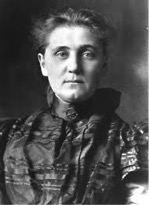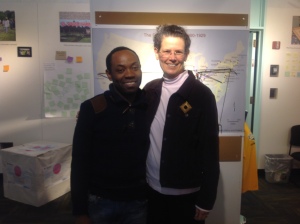On Wednesday, March 11, 2015, the African-American Cultural Center featured a special Brown Bag event, “Black Deaf Culture & History: A Conversation with Benro Ogunyipe, Moderated by Manako Yabe.”
Mr. Ogunyipe, an Accessibility Specialist for the State of Illinois, Department of Human Services in Chicago, is responsible for conducting site inspections for accessibility requirements, investigating disability discrimination complaints, and providing quality resources and accessible services to accommodate persons with disabilities.
His thought-provoking presentation highlighted several aspects of Black deaf culture through a historic lens. Some of the issues that Mr. Ogunyipe spoke of examined Deaf communication etiquette, segregation in Deaf schools, Black Deaf firsts, the civil rights movement, Black Deaf organizations, and notable books and schools that are geared towards the Black Deaf community.
There are over 48 million deaf and hard of hearing people in the USA who have from profoundly deaf to mild hearing loss. One of the most fascinating issues that Mr. Ogunyipe spoke of was, communication etiquette when using a Sign Language Interpreter:
- Direct eye contact with the Deaf person when signing or speaking to him/her, not the interpreter.
- Address the Deaf person directly:
– Appropriate communication: “Where were you born?”
– Inappropriate communication: “Ask him where he was born.”
- Speak in your normal tone of voice at a moderate pace. The interpreter will tell you if you need to pause, slow down or
repeat the information.
- If you are unsure of the appropriate way to proceed in a particular situation, feel free to ask!
Acceptable vs. Unacceptable Terms
Preferred/Acceptable Terms
- Deaf
- Hard of Hearing
- Deaf-Blind
- Late-Deafened
- Hearing Loss
Objectionable/Unacceptable Terms
- Deaf-Mute
- Deaf and Dumb
- Hearing Impaired
Here are some of the highlights from Mr. Ogunyipe’s presentation:
Black Deaf persons often experienced double prejudice against them in terms of racial discrimination and communication barriers. Black Deaf women may experience three strikes of prejudice due to their race, Deafness, and sexist practices that prevail in the male dominated culture.
Discriminatory practices can be traced back to the segregation era during the 17th to mid-20th centuries. Black Deaf individuals were not accepted in either the Deaf or the African-American community.
Because Black Deaf students were prohibited from opportunities to interact with students and teachers on the White Deaf school campuses, this separation contributed to the development of Black ASL, a dialect of American Sign Language that’s distinctly different from those of White Deaf students’ signs.
Gallaudet University
Gallaudet University is a federally chartered private university for the education of the Deaf and hard of hearing located in Washington, D.C.
Founded in 1864, Gallaudet University was originally for both deaf and blind children. It was the first school for the advanced education of the deaf and hard of hearing in the world and remains the only higher education institution in which all programs and services are specifically designed to accommodate deaf and hard of hearing students. Hearing students are admitted to the graduate school and a small number are also admitted as undergraduates each year. The university was named after Thomas Hopkins Gallaudet, a notable figure in the advancement of deaf education, who himself was not deaf.
Black Deaf Firsts
- At the 100th anniversary of the National Association of the Deaf (NAD) in July 1980, a Black Deaf caucus was held. Black deaf caucus members presented issues of the NAD’s lack of attentiveness to the concerns of Black Deaf Americans as well as the lack of representation of Black Deaf individuals as convention delegates. The first Black Deaf Conference entitled “Black Deaf Experience” was held June 25-26, 1981 at Howard University in Washington, DC
- The first Black Deaf student to graduate from Gallaudet University & Father of Deaf Education in Africa was Andrew J. Foster.
- The first Black Deaf female to graduate from Gallaudet University was Ida Hampton.
- The first Black Deaf to earn a Ph.D. was Dr. Glenn Anderson.
- The first Black Deaf female to earn a Ph.D. was Dr. Shirley Allen.
- The first Black Deaf lawyer was Claudia Gordon, Esq.
Notable Black Deaf Books
Black and Deaf in America: Are We that Different? – authored by Dr. Ernest Hairston and Linwood Smith (1983)
Still I Rise: The Enduring Legacy of Black Deaf Arkansans Before & After Integration – authored by NBDA Board Member, Dr. Glenn B. Anderson (2006)
The Hidden Treasure of Black ASL: Its History and Structure – authored by NBDA member, Dr. Carolyn McCaskill (2011)
On The Beat of Truth: A Hearing Daughter’s Stories of Her Black Deaf Parents – authored by Maxine Childress Brown (2013)
For more information on Black Deaf culture visit the NBDA Website: http://www.ndba.org


























 Rankine, Henry G Lee Professor of English at Pomona College, is co-editor of American Women Poets in the Twenty- First Century series with Wesleyan University Press and The Racial Imaginary with Fence Books
Rankine, Henry G Lee Professor of English at Pomona College, is co-editor of American Women Poets in the Twenty- First Century series with Wesleyan University Press and The Racial Imaginary with Fence Books






